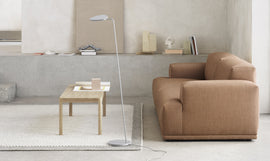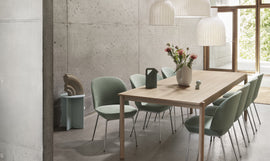The new heart of the home is quite possibly the living room—a place to unwind, relax and enjoy the company of family and friends. The focus of any living room is the sofa, be it a spacious modular so the whole gang can stretch out or a more compact piece ideal for apartment living.
A sofa will set the tone for the room and is often a big investment so it's worth getting it right.
Style
Will it be a place to lounge around and have fun, a more formal space to entertain, will it be primarily used by the kids and their friends or does the room need to be accessible for the elderly or those less mobile?
With so many choices when it comes to fabrics, shape and configuration, start by defining a style that will complement both your lifestyle, your family's needs and the existing decor in your home. Your home's era and architecture may also inform your decision.
A contemporary sofa with clean lines and simple shapes will fit seamlessly into a modern home, but can work equally as well in a more traditional home, a striking way to contrast heritage features, updating a space for modern living.
Functionality
Consider how the sofa will be used and by whom—families may require a comfy, robust sofa, one made to withstand spills and marks, grubby hands and lots of action. If a dog resides with the family the same may apply especially if they're used to cuddling up with their humans. Something more structured may be better suited to those who will use a sofa less, someone motivated to keep it looking its best over time.
Size
Sofas come in all shapes and sizes. Consider the size of the room first as this may dictate what is possible—scale is important. It needs to fill the space but not overwhelm it. Don't be afraid to put a large sofa in a small room, especially if it means improved functionality for the family. A sofa with clean lines will reduce visual noise in the room, creating a welcoming and unfussy space.
Consider the height of the people using the sofa—those with longer legs will appreciate a deeper sofa that can accommodate their stretch but smaller people will benefit from a sofa with a shallower depth. The height of the sofa is also important, especially if there are older people or those with mobility issues in the family—a low sofa requires a little more effort when sitting and rising, something with more back support may work better.
You will want to leave a minimum of 900mm around the side for thoroughfares. Don't forget rugs, coffee tables and side tables—the average side table is around 500mm in diameter. Coffee tables and rugs vary in size—once you've chosen your sofa, you'll have a better idea which sizes to choose.
If you've got an open-plan space and the sofa will back on to one part of the space, a low-lying sofa will keep the space looking open and more spacious. It will also work well pushed up against a wall, leaving ample room for the placement of artwork, just remember to position any artwork higher than seated head height.
If in doubt, cut out paper shapes—sofa, coffee table, side table, floor lamps and existing furniture pieces such as armchairs, sideboards and entertainment units and position them in the room to see how it all works together. Remember to check door widths too to ensure any new purchases will actually make it into the room!
Comfort
Let's face it, a sofa has to be comfortable. Inserts can be feather-filled, foam-filled or a mix of both. Feather sofas are super-comfy but they will sag over time, requiring plumping and possibly refilling whereas foam as low maintainence but firmer in texture, not ideal for long, lazy days in front of the tv. Goldilocks would probably opt for the mix, with a core made of foam, wrapped in feathers.
Fabric
Contemporary sofa fabrics are incredibly durable and long-lasting, ideal for busy families and investment pieces made to last a long time. Leather is durable and easy to clean but it can be cold so it may need some fabric cushions and cosy throws to soften the look. Fabric sofas are comfy and inviting but can need a little more care, with spills and stains attended to quickly to avoid staining. Textured weaves are more forgiving of dirty marks, extending the life of the sofa.
Colour
As with all big investments, bold patterns and colours will date quickly whereas neutral colours will stand the test of time and can be easily updated with accessories as tastes and trends evolve. Order a swatch and see how the colour works within the room at different times of the day. Take into consideration existing artworks, rugs or other furniture pieces that need to work with the new sofa. A moodboard is an easy way to check that everything works together—if not a physical collection of magazine clippings, colour and fabric swatches and furniture images, a Pinterest board collating everything together.
Try before you buy
Where possible, have a sit on the sofa and test it out. You'll instantly get a feel if it will be the right choice for you and your family.
At Oscar and Willow, we have a great range of fully customisable sofas available in different shapes, sizes, fabrics and configurations. We are always happy to discuss any concerns or queries you may have to help you find the best possible sofa for you.


